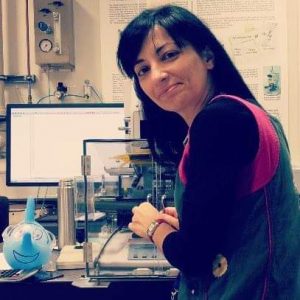Dr Maria C. Hernandez-Soriano
Postdoctoral Scientist WISH-ROOTS coordinator team
Maria is a soil chemist, intrigued by the complexity of the chemical and biological processes that happen in soil and make it healthy and productive.
Carbon, nitrogen and phosphorous are essential for all organisms and are stored in soil in different chemical forms as a result of interactions with the minerals in the soil and the activity of soil organisms. Some forms of these nutrients, the bioavailable pool, can be taken up by plants and other organisms to function.
Maria’s work involves investigating how plants and soil bacteria communicate by producing and releasing chemical compounds in the rhizosphere, that is, the soil in contact with the plant’s roots.
One key aspect of this communication is to make an efficient use of the nutrients available in the soil. Particularly, some ancient or wild varieties of important crops, such as wheat, can release chemical compounds from their roots that control the transformation of nitrogen by soil bacteria called biological nitrification inhibitors (BNIs) – this can reduce the loss of nitrogen fertiliser from soils and nitrogen can be retained for longer time in soil so the plant can have more time to use it.
Currently, nitrogen fertiliser is quickly transformed into water soluble forms by soil bacteria, thus being washed off the field. This inefficient use of nitrogen fertiliser results in higher costs for farmers as well as environmental issues such as increased emissions of greenhouse gases and pollution of waterways. It is important to develop ways to keep nitrogen in field soils for longer to give more productive crops, reducing the amount of fertiliser that is required and the associated environmental impact.
Maria is using a collection of more than 100 modern and historical varieties of wheat held in our Germplasm Resource Unit, the Watkins collection. These varieties are grown in our field station, and the roots and the rhizosphere soil, collected after the harvest. Maria then combines different chemical and biological methods to measure the capability of different varieties of wheat to produce BNIs and control nitrogen transformation by bacteria.
Using advance statistical methods, the lab can link the variability in this capacity (trait) across wheat varieties with the variability in the wheat genome and identify the genes responsible for the production of these compounds. In the long-term the goal is to reintroduce this trait in the modern wheat varieties that we cultivate using breeding programs.
Recovering traits from historical varieties into modern varieties is key for a more sustainable agriculture: we can learn from natural interactions between plant – soil organisms and we can use this knowledge to grow our crops with practices that preserve the fertility of our soils.
Before joining the John Innes Centre, Maria worked for several years on carbon sequestration in soil – some forms of carbon are used by soil organisms to obtain energy while other forms are stored in soil as organic matter.
In natural soils, carbon can be preserved for hundreds of years as organic matter protected in small structures that we call soil aggregates. Using advanced microscopy and biological tests, Maria found that composition of organic matter and closely related biological processes were dramatically different between forest soils and soils dedicated to agriculture or pasture. We can use this information to develop models to predict how to store carbon in soil.
Maria is a postdoctoral scientist working in the WISH-ROOTS project with Tony Miller, Simon Griffiths and Luzie Wingen.
